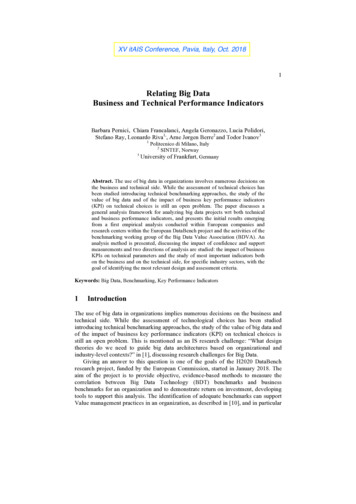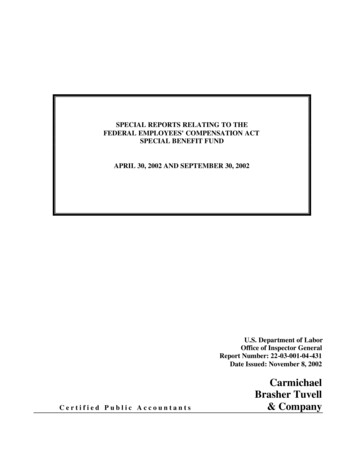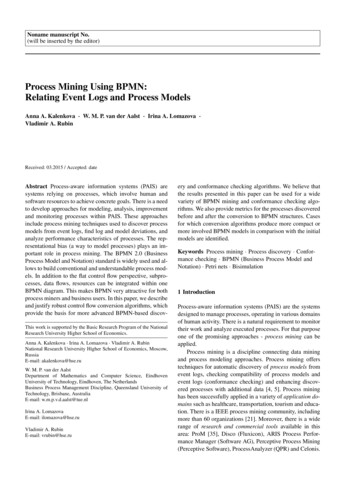
Transcription
XV itAIS Conference, Pavia, Italy, Oct. 20181Relating Big DataBusiness and Technical Performance IndicatorsBarbara Pernici, Chiara Francalanci, Angela Geronazzo, Lucia Polidori,Stefano Ray, Leonardo Riva1,, Arne Jørgen Berre2 and Todor Ivanov31Politecnico di Milano, Italy2SINTEF, Norway3University of Frankfurt, GermanyAbstract. The use of big data in organizations involves numerous decisions onthe business and technical side. While the assessment of technical choices hasbeen studied introducing technical benchmarking approaches, the study of thevalue of big data and of the impact of business key performance indicators(KPI) on technical choices is still an open problem. The paper discusses ageneral analysis framework for analyzing big data projects wrt both technicaland business performance indicators, and presents the initial results emergingfrom a first empirical analysis conducted within European companies andresearch centers within the European DataBench project and the activities of thebenchmarking working group of the Big Data Value Association (BDVA). Ananalysis method is presented, discussing the impact of confidence and supportmeasurements and two directions of analysis are studied: the impact of businessKPIs on technical parameters and the study of most important indicators bothon the business and on the technical side, for specific industry sectors, with thegoal of identifying the most relevant design and assessment criteria.Keywords: Big Data, Benchmarking, Key Performance Indicators1IntroductionThe use of big data in organizations implies numerous decisions on the business andtechnical side. While the assessment of technological choices has been studiedintroducing technical benchmarking approaches, the study of the value of big data andof the impact of business key performance indicators (KPI) on technical choices isstill an open problem. This is mentioned as an IS research challenge: “What designtheories do we need to guide big data architectures based on organizational andindustry-level contexts?” in [1], discussing research challenges for Big Data.Giving an answer to this question is one of the goals of the H2020 DataBenchresearch project, funded by the European Commission, started in January 2018. Theaim of the project is to provide objective, evidence-based methods to measure thecorrelation between Big Data Technology (BDT) benchmarks and businessbenchmarks for an organization and to demonstrate return on investment, developingtools to support this analysis. The identification of adequate benchmarks can supportValue management practices in an organization, as described in [10], and in particular
in structural practices such as the Value management office and in process practices,namely benefits management and risk management.The paper discusses a general analysis framework for analyzing big data projects,discussing both business performance indicators and IT technical indicators emergingfrom the analysis of ongoing European research projects on Big Data, and presentingthe first results emerging from an initial empirical analysis conducted withinEuropean companies and research centers within the European DataBench project andthe activities of the benchmarking working group of the Big Data Value Association(BDVa)1. The issue of relating IT performance and measuring value [10] andmanaging value [9] of information systems has widely been debated in the literature,in which studies deriving indicators based on case studies are proposed.In this paper, an analysis method is presented, discussing the impact of confidenceand support measurements and two directions of analysis are studied: the impact ofbusiness KPIs on technical parameters and the study of most important indicatorsboth on the business and on the technical side, for specific industry sectors, with thegoal of identifying the most relevant design criteria. With reference to theclassification presented in [9], as our approach is oriented to consider indicators toevaluate Big Data systems benchmarks, we consider indicators with a BusinessOperations focus, including external service delivery and IT operations indicators.While IT technical indicators have been analyzed in the literature [9], and can bederived from reference models, such as the ones introduced by BDVa in [2] and NISTin the NIST Big Data Reference Architecture) [8], performance indicators from thebusiness perspective still need further investigation in this area.As discussed in [5], starting from empirical evidence, industries in the IT sectorand highly competitive industries are able to extract value from Big Data, while inother industry groups there is a need to find a measurable impact of this technology.The goal of the paper is to define business and technical indicators and to studyhow to find relationships among indicators. The main aim is to profile industrysectors wrt Big Data Analytics (BDA) and to find the significant indicators forassessing its value to organizations.The developed methodology is based on desk analysis and a questionnaire tocollect data from the European research space, in particular from participants inProjects on Big Data within the Private-Public-Partnerships (PPP) in 2014-152. Thequestionnaire has been developed within the DBVa Benchmarking working groupwith the goal of collecting information about both business and technical aspects.The paper is structured as follows. Section 2 introduces a first new frameworkdeveloped within DataBench to classify business performance indicators. Then, inSection 3, the technical indicators derived from the analysis of existing referencearchitectures are illustrated. Section 4. describes the methodological approachfollowed to analyze the results of the questionnaire to collect data about ongoingprojects and Section 5 presents and discusses the first conclusions that can be derivedfrom the e-partnership
32Business performance indicatorsThe literature on the relationship between IT (information technology) and businessbenefits is vast. A largely accepted assumption of this literature is that if a companymakes a major investment in IT, the benefits of the investment should be measurablewith a business performance indicator [10]. IT is attributed an importantorganizational role and IT’s impact is considered pervasive [12], tangible [14] andmeasurable with both financial and non financial business performance indicators,often referred to as business KPIs (key performance indicators, cf. [11]). The nextsection provides a classification of business KPIs, grounded on previous literature.2.1Categories of indicatorsBusiness KPIs have been classified in several different ways in previous literature. Afundamental distinction is made between financial, or economic, and non financialKPIs [10]. There is general agreement that a correct evaluation of benefits from amajor IT investment should be based on multiple KPIs. For example, authors in [11]have introduced the concept of balanced scorecard as a basis for the design ofmanagement control dashboards in the design of executive information systems.Similarly, [13] considers the combined use of financial and non-financial KPIs asmore effective in the assessment of strategic decisions.In DataBench, we focus on use cases of big data & analytics projects and aim atthe assessment of benefits at a use-case level. An example use case could be theapplication of machine learning techniques in loyalty marketing and a correspondingbenefit could be the reduction of customer churn. In turn, the measurable businessKPIs that can be associated with a reduction of churn could be customer satisfactionand revenue growth. In DataBench, we are conducting a desk analysis to collect andclassify big data & analytics use cases. So far, we have classified 75 use cases in 9different industries. The next section discusses how these KPIs represent afundamental dimension of the more general framework that we have used to classifyuse cases and to contextualize the measure of business KPIs.2.2Modeling business indicatorsFigure 1 shows a table where different dimensions represent characteristics of usecases that have to be assessed in order to support the high-level design of thetechnology architecture and the selection of corresponding technical benchmarks (seeSection 3). These characteristics have emerged from the analysis of a total of 75 bigdata projects based on our preliminary desk analysis. For example, the industry hasemerged as an important factor driving high-level technical choices and thecorresponding selection of technical benchmarks. We have observed that in the retailindustry, the adoption of non-relational technologies is not seen as a business enabler,as retail data are mostly structured and data schema changes are not frequent.Consequently, technical benchmarks designed for non-relational technologies are less(or not) needed in retail, compared to other industries, such as financial services,
where handling documents and applying varying tag sets with semantic technologiescan result in frequent data schema changes.Current work in the DataBench project is focusing on completing the classificationof big data project characteristics based on the desk analysis and experimenting themin field studies. As shown in Figure 2, business indicators are grouped incharacteristics. Business indicators represent a classification dimension that has arelationship with the choice of technical benchmarks that is mediated by other bigdata project characteristics. A project classified with a multi-dimensional model islikely to use specific technical benchmarks. In turn, the correct design of thetechnology architecture aided by the technical benchmarks represents an enabler ofspecific business KPIs.IndustryBig DataMaturityKPIFinanceCurrently usingCost reductionManufacturingPiloting orimplementingTime efficiencyRetail &WholesaleConsidering orevaluating forfuture useTelecom/ MediaNot using and noRevenue growthplan to do essionalservicesScope of Big Data& AnalyticsGovernamental/EducationHealthcareDB & AnalyticsApplicationDecisionDataSalesoptimization task EnterpreneursData drivenbusinessprocessesData nCustomersatisfactionBusiness modelinnovationLauch of newproducts and/orservicesData UserSize ofBusinessData size Datasource5000 or more Gigabytes DistributedCustomerVendors in theservice &ICT industrysupport2500 to 4999 Terabytes CentralizedUsercompanies1000 to 2499 PetabytesIT & dataoperationGovernance risk250 to 999& complianceProductmanagement50 to 249Marketing10 to 49ExabytesMaintencance &less than 10logisticsProductinnovationHR & LegalR&DFinanceFig. 1. Big data business indicators3Technical indicatorsFigure 2 shows the mediated relationship between technical benchmarks and businessKPIs discussed in the previous section. Different technical benchmarks evaluatedifferent technical features and provide different output metrics, accordingly. Thegoal of DataBench is to understand the decision variables that should be considered tochoose the right technical benchmark, which, in turn, can help delivering businessbenefits. Section 3.1 reports a classification of technical benchmarks and relatedoutput metrics. Section 3.2 shows a preliminary technical decision framework.
5Fig. 2. The mediated relationship between business KPIs and technicalbenchmarks.3.1Categories of benchmarks and output metricsFigure 3 shows a matrix positioning the Big Data benchmarks being developed in [15]according to different criteria defined in the BDVA Reference Model [2]. On the left(in blue) are listed the different industry application domains, data types andtechnology areas. On the bottom (in green) in a release time order all the main BigData benchmarks are listed. Different technical benchmarks show a clearly differentfocus in terms of features that are benchmarked. There is no complete benchmarkingsuite and companies have to make a decision on which benchmarking tool is bestsuited to their application purposes. However, there is no clear correlation betweenthe characteristics of the technical benchmark and the architectural choices that thecompany should make, which, in turn, depend on the characteristics of the big-dataproject.3.2Modeling technical decision variablesFigure 4 represents a first attempt developed in DataBench to classify technicalindicators to select key decision variables in the choice of the technical benchmark. Inaddition to characteristics related to the output metric and the system, the nature of thetask to be accomplished seems to represent a key decision variable. For example, insome cases companies have very complex predictive analytics to execute and need tomake sure that the algorithm that they choose is efficient at using available computingcapacity. In other cases, they are concerned with more traditional benchmarksevaluating the response time of a DBMS at retrieving information from large SQLtables with a different schema design. As for business indicators, the table provides aclassification of indicators in characteristics (from Metrics to Platform features).4Relating indicatorsThe objective of this section is to define systematic analyses that have to beperformed in order to gather evidence about the importance of single indicators in BigData systems and their relationships. The analysis also aims to profile the gatheredinformation by focusing on some specific aspects, such as for instance industrysectors, or specific technical or business characteristics.
Fig. 3. Classification of technical benchmarks (source: [15])
7MetricsData TypesBenchmarkData UsageStorage TypeProcessingTypeAnalyticsTypeExecution time/LatencyBusinessIntelligence(Tables,Schema )Synthetic dataDistributedFile SystemBatchDescriptiveThroughputGraphs, LinkedDataReal dataDatabases/RDBMSStreamDiagnosticData PipelinePrivacyCostTime Series, IoTHybrid (mix ofreal andsynthetic) dataNoSQLInteractive/(near) Real-timePredictiveData wSQL/ InMemoryIterative/InmemoryPrescriptiveData WarehouseGovernanceAccuracyText (incl.NaturalLanguage text)Time SeriesLambdaArchitectureData QualityPrecisionMedia (Images,Audio andVideo)KappaArchitectureVeracityUnified Batchand urePatternsPlatformFeaturesData Preparation Fault-toleranceDurabilityDataManagementCPU and MemoryUtilizationDataVisualizationFig. 4. Characteristics of technical benchmarks.In this section, the analysis process is delineated, while in next section the firstoutcomes of the DataBench project, obtained combining desk analysis and the resultsof an online questionnaire, are illustrated.In the following, N will indicate the number of collected responses. Multipleresponses for an indicator are possible. In this section, indicators are the possiblevalues for each category (e.g., small, medium, large for size category are consideredas three indicators).POS(Ii) indicates a positive answer to one value of an indicator, POS(I1,.,In)indicates the number of positive answers to a question in the questionnaire, wherePOS(I1,I2) indicates positive answers to both indicators I1 and I2.4.1Identifying common goals in Big Data ProjectsA first goal is to identify the most popular indicators in Big Data projects. For eachcategory, the most popular answers will be identified. There are two elements to beconsidered: the percentage of answers supporting the indicator within a decisionvariable and a threshold to establish when the percentage is significant to support theindicator. To this purpose two formulas are used:confidence: POS(Ii) / 1,n POS(Ii)to indicate the significance of the indicator within a decision variable with n possiblevalues and
support: POS(Ii)/Nto indicate the support for a given indicator, i.e., the percentage of positive answerssupporting the indicator on the collected data.4.2 Analyzing dependencies among indicatorsThe goal of this analysis is to capture significant dependencies among pairs ofindicators. The analysis is therefore based on POS(Ii, Ij) values.Depending whether the interest is in analyzing the impact of indicator Ii on Ij (orvice versa), the relative importance for the indicator of interest is assessed with thefollowing formula:cross-significance: POS(Ii,Ij) / 1,n POS(Ii) (if we focus on Ii, otherwise the sumis over Ij), where Ii and Ij are indicators belonging to different types of characteristics.This analysis is useful to find significant relationships between indicatorsbelonging to different categories, e.g., to assess if a given business indicatorinfluences technical choices, or if given technical choices are more common in givenbusiness situations. An example is shown in Figure 5, derived from the field analysisillustrated in Section 5 (in this first questionnaire also margin growth was considered,which is been considered as a more detailed indicator linked to cost reduction andrevenue growth and therefore not shown in Figure lPredic4vePrescrip4veFig. 5. Example of cross-significance analysis business KPI (x-axis) vs Analysis type(y-axis)4.3 Profiling on a pivot indicatorThe analysis techniques presented above can be used to focus on one characteristicand analyze its implications on other characteristics.
9For instance, starting from the ‘Industry’ characteristic, each industry type can beprofiled, selecting all most significant indicators in other characteristics for suchindustry type.The analysis is based on the use of one indicator Ii as the pivot indicator, andidentifying the cross-significance for the other indicators. The most significant foreach category are selected as representative indicators in the profile, based on athreshold. The threshold can be set considering the significance and precision of theindicator in the data set.5Results from a first field analysisIn the following, we perform our analysis considering some of the above-mentionedindicators, analyzing the results of a questionnaire on business, technical, andbenchmarking aspects developed within the BDVa Benchmarking group and forwhich answers were collected in the period March-May 2018. Respondents wheremainly participants in European PPP Big Data projects, for a total of 36 responders,representing 37 different projects. The questionnaire is synthetically reported in theappendix.In the questionnaire, we analyzed the most important indicators using the profilingtechnique illustrated in Section 4.3, and the indicator category [D5] “What are yourBig Data application domains”, which can assume the following values:Energy, Financial Services, Manufacturing, Construction, Food/Agriculture, Retail,Wholesale/Professional services, Transport Services, Public Administration,Healthcare, Education, Telecom/IT/Media, Utilities.We present in Figure 6. the profile obtained for the Manufacturing domain,selecting the indicators that have high confidence in the domain, i.e., for which mostof the respondents in the sectors indicated an interest.From the analysis illustrated in Section 4.1, we also derive that some of theseindicators are generally significant across industry sectors, e.g., the answer indicatingcompliance wrt business requirements and specifications for D10 is common to mostsectors.6Concluding remarksIn this paper, we have discussed our preliminary results in the definition of aframework to tie the use of technical benchmarks to business indicators. Theassumption underlying this study is that technical choices play a strategic role in bigdata projects and the use of technical benchmarks is of pivotal importance to helparchitectural choices. The link between technical benchmarks and business indicatorscan be used in both directions, to help t
of the impact of business key performance indicators (KPI) on technical choices is still an open problem. This is mentioned as an IS research challenge: “What design theories do we need to guide big data architectures based on organizational and industry-level contex











